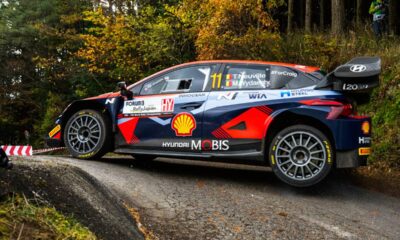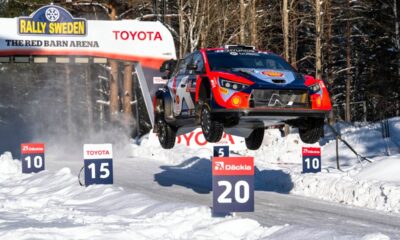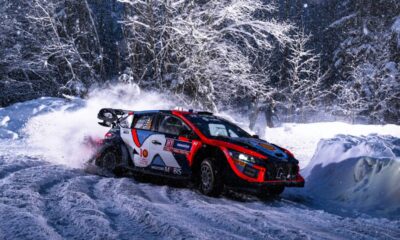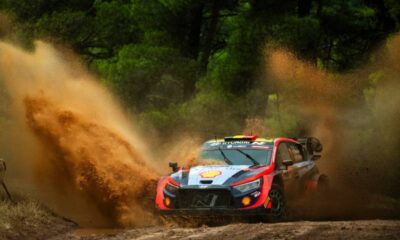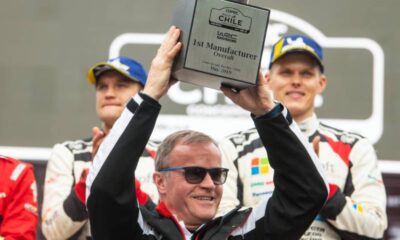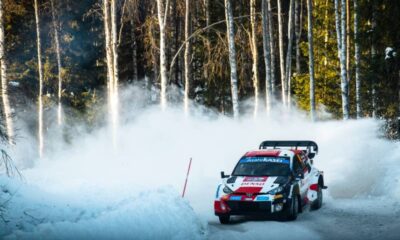Motorsport
A legendary and absolutely iconic brand of world rallying: Why did Subaru decide to leave the WRC in 2008?
The Subaru Impreza is now an unquestionable and absolutely iconic brand in rally racing. In the WRC, Subaru has achieved three Constructors’ Cup titles and a further three Drivers’ Championship championships. The Japanese team was simply a force to be reckoned with and they were almost always a dangerous and worthy opponent. However, in 2008, something came along that forced Subaru’s exit from the WRC…

The Subaru Impreza is now an unquestionable and absolutely iconic brand in rally racing. In the WRC, Subaru has achieved three Constructors’ Cup titles and a further three Drivers’ Championship championships. The Japanese team was simply a force to be reckoned with and they were almost always a dangerous and worthy opponent. However, in 2008, something came along that forced Subaru’s exit from the WRC…
A legendary and utterly iconic brand. Subaru and their Impreza model is one of the most iconic representatives of not just rally racing, but motorsport as a whole. It should be noted that the brand’s motorsport history is firmly tied to rallying.
And this history goes back to the early 1980s. Back then, Subaru entered the world of rallying with the Leone and the first event the Japanese manufacturer took part in was the famous Safari Rally.
Although Subaru has participated in the World Rally Championship at various times since 1980, their starts have been rather sporadic. Ari Vatanen, Per Eklund, Shekhar Mehta, Mike Kirkland, Possum Bourne and Harald Demuth – these were the drivers who defended the team’s colours in Subaru’s early days. The team’s best result and only podium finish came in New Zealand in 1987, when they finished third in the final showdown.
Subaru World Rally Team
It was only in September 1989 that the Subaru World Rally Team was formed in the form in which it has been known to fans around the world for many years. Subaru Tecnica International (STi) President Ryuichiro Kuze partnered with British firm Prodrive to create the Legacy RS for the World Rally Championship.
Subaru thus finally had its own team in the WRC at the stroke of the 1990 season. The Japanese team’s car subsequently became an icon of world rallying, winning millions of fans around the world.
By 1992, the team was racing the Legacy RS Turbo, and it was this model that brought the iconic blue and gold combination to Group A (the designation for championship cars at the time – ed.). Already in its first full season in the WRC, Subaru scored 43 points and ended the 1990 season in fourth place in the Constructors’ Cup.
Although Subaru only scored one point less a year later, it was only enough for the Japanese stable to finish sixth. The 1992 season, however, saw an improvement in results and Subaru was back in fourth place in the Constructors’ Cup with 60 points.
The Subaru Impreza – the model that started many
In 1993, Subaru came up with a major innovation. It was from this season that the Japanese team began using the Impreza, then designated 555, for rally events. The Legacy took its first and last WRC victory in New Zealand in August 1993.
However, Subaru ended that year in third place in the Constructors’ Cup, having collected 112 points consecutively. Meanwhile, the Japanese stable would have achieved two wins overall in that year had it not been for a windscreen defogging problem in the Finnish rally (just two weeks after Legacy’s victory in New Zealand).
As a result of these problems, Vatanen finished second in Finland. The following year, Subaru and the Impreza scored three wins, and by the end of the event they had 140 points. Even this bold points haul was not enough to take the overall first place, which, as in 1993, went to Toyota.
It should be added, the 1994 Greek Rally saw the Impreza claim its first WRC victory. And thanks to constant improvement and ingenious development, this particular model has become very strong for rally racing.
1995 – 1997:: Subaru domination
Subaru became a serious contender for the title. And the Japanese marque confirmed this – in the following three years they climbed to the top step of the podium, and in the 1995 season Subaru also won its first title among the drivers.
Colin McRae (90 points) beat second-placed Carlos Sainz by five points in the final showdown. McRae came close to the title in 1996 and 1997, but then he was no match for the aforementioned Mäkinen. On both occasions, he had to settle for second place, although in 1997 the legendary Finnish racer only beat him by a single point.
Subaru dominated the constructors’ standings with 350 points, 43 points ahead of second-placed Mitsubishi. For four years from the 1996 season, Finn Tommy Mäkinen reigned over the World Rally Championship, just in the colours of the Japanese team. The constructors, however, were dominated by Subaru in 1996 and 1997.
For the 1997 season, however, the FIA was to introduce many changes in terms of regulations. The International Automobile Federation created the WRC class then, the cars became wider, lower and more powerful. Redesigned geometry, suspension and slightly wilder aerodynamics were other hallmarks of the new era’s cars.
The Impreza WRC97 was the first of a new breed of competition cars, while still remaining that iconic sports car. And, as we write above, that didn’t stop Subaru taking another Constructors’ Cup championship.
1998 – 2001:: Another drivers’ title
Although the Impreza was considered a showcase car for a new technological era, the Japanese designer, in conjunction with Prodrive, used the fly-by-wire system for the first time, Subaru ended the 1998 season in third place behind Mitsubishi and Toyota.
In the following year, however, Subaru finished just below the top in both the Constructor’s Cup and the Drivers’ Championship. Richard Burns took second place in the final standings, having amassed 55 points overall in the 1999 season. Seven points more than the winner of that year, Mäkinen.
And in the team standings, Subaru (105 points) was just four points behind the winning Toyota (109 points). Burns also had to settle for second place a year later, losing five points to champion Marcus Grönholm in a Peugeot. Subaru finished third in the Constructors’ Cup with 88 points.
While the 2000 season marked the end of the two-door Imprezas for Subaru, the 2001 model year brought a completely new look for the car. The Impreza adopted its four-door look and resembled a road-going version of the STI. This new body design also proved to be a staggering 250% stiffer than the 2000 car.
However, this did not prevent subsequent events – in the 2001 season, Subaru won another drivers’ title, which was won by Burns after a long wait. In the Constructors’ Cup, however, Subaru was only fourth.
King Petter Solberg
The years 2000 – 2002 were simply a period when Peugeot ruled all the teams, led by Marcus Grönholm, who returned the drivers’ title to Peugeot in the 2002 season, with an absolutely commanding 40-point lead over second-placed Solberg.
But in 2003, everything was different. The Citroën team claimed its first ever Constructors’ Cup title with the Xsara, with the French team on the cusp of a spectacular dynasty – the stable dominated the World Championship each of the next nine years.
2003 was the last year that the drivers’ championship was dominated by someone other than the then emerging legend Sébastien Loeb. This season, he was still able to beat Nor Solberg by one point in his iconic Impreza.
2004 – 2006:: Ford and Citroën dominance
Even with a controversial front-end design that wasn’t to everyone’s liking, the Impreza remained a firm fan favourite in 2004 and 2005. The team’s pursuit of perfection gave rise to arguably one of the best WRC cars to date, the Impreza WRC2005.
The Impreza held the favoured Citroën and Ford tooth and nail at every event and helped bring the event itself into the mainstream media.
In 2004, Subaru finished third, with Solberg finishing second in the drivers’ championship with 82 points, scoring five victories. Solberg retained his place just below the top in the following year, albeit with eleven fewer points.
In the Constructors’ Cup, however, Subaru was no match for three teams (Citroën, Peugeot, Ford). Solberg, it should be noted, was getting the absolute most out of the Impreza. The other two drivers, Mikko Hirvonen and Chris Atkinson, scored a combined total of just 27 points. Solberg himself managed 71.
This battle between manufacturers continued into the 2006 season, when Subaru came out with a new version of its car. The improved Impreza was extensively revised to meet the increasingly stringent FIA rules and regulations. The International Automobile Federation even monitored the use of spare parts.
Subaru returned to third position in the final Constructors’ Cup standings in 2006, but the team was far from winning. Solberg did not score a single win, with only three second places in Mexico, Argentina and Australia as consolation. In the final drivers’ championship table, he was only sixth.
2007 – 2008:: Final seasons in the WRC
The Impreza WRC2007 underwent further development and facelift and was the car that ended the long tradition of four-door saloons. The result was third place in the Constructors’ Cup and another year of dominance by Ford and Citroën. Solberg scored only two podium finishes this time, thanks to a second place in Portugal and a third in Greece.
He finished fifth in the final driver standings with forty-seven points. Subaru fans witnessed almost identical results in the 2008 season – another third place behind Citroën and Ford, with Solberg and Atkinson closing out the drivers’ championship in fifth and sixth.
Then, on 16 December 2008, Japanese car company officials announced that Subaru was retiring from the World Rally Championship. This decision was made by Subaru together with Fuji Heavy Industries, partly as a result of the economic downturn. And partly because, plain and simple, it seemed to all the performers that Subaru had achieved its sporting and marketing objectives.
Ikuo Mori, then head of FHI, subsequently denied that changes to the WRC technical regulations in 2010 or the alleged deterioration in working relations with Prodrive had any influence on that decision. He also said there was a possibility that Subaru would return to the WRC in the future.
For fans, a Subaru return would clearly be a dream come true. At the moment, however, there is a big question mark hanging over whether that wish will come true.
The impact of motorsport on the automotive industry
During the 1990s, success on the global rally scene helped shift Subaru’s sales profile from low-value small passenger vans (mostly in the domestic Japanese market) to high-value models (Legacy, Impreza and Forester) sold globally.
From 1990, when the first competition car arrived on the scene, to 2008, Subaru has transformed itself from a virtually unknown Japanese passenger car and mini-van manufacturer to a global and respected brand.
Notably, this particular team is considered one of the best examples of how motorsport can greatly help and increase sales for the brand itself.
Sources: DirtFish, WRC, Subaru World Rally Team

